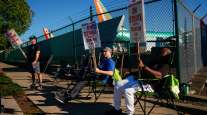Senior Reporter
Decline in Demand to Affect Trucking Freight, Economists Say

[Stay on top of transportation news: Get TTNews in your inbox.]
The upcoming retail holiday season is likely to see slower sales below the surging pace of 2021 as the U.S. economy’s pace of growth slows to a much lower level, which will have an impact on the amount of freight shipped by trucking.
Also impacting the transportation field is the shift to a more balanced economy, with the service side seeing an uptick in spending and a decline in the once-red-hot goods side as consumers return to more traditional spending patterns.
“Demand is falling away and, finally, we’re to the point where consumer expenditures on imports are slowing,” Paul Bingham, director of transportation consulting at S&P Global Market Intelligence, told Transport Topics. “The capacity that has been deployed is down to the point that is necessary and can handle the amount of volume that is being shipped, and it’s only September.”

Bingham
Bingham said that slowdown is good news for the U.S. ports and other parts of the supply chain because the backlog of ships at those facilities has significantly been reduced. That means there is additional capacity that did not exist a year ago, when more than 100 ships were waiting in San Pedro Bay, outside of the ports of Los Angeles and Long Beach, sometimes waiting as long as 14 days for berths so they could be unloaded.
A new report from the National Retail Federation confirms Bingham’s analysis of the transportation sector.
NRF said even as inflation begins to moderate as the Federal Reserve’s higher interest rates cool the economy, imports at the nation’s ports are expected to dip below 2021’s record levels for the rest of 2022, according to the Global Port Tracker report released Sept. 7 by NRF and Hackett Associates.

Packages at a UPS facility. The company recently announced it will hire 100,000 seasonal workers to handle holiday shipping. (Luke Sharret/Bloomberg News)
“Consumers are still buying, but the cargo surge we saw during the past two years appears to be slowing down,” NRF Vice President for Supply Chain and Customs Policy Jonathan Gold said. “Cargo volumes are solidly above pre-pandemic levels, but the rate of growth has slowed and even slid into negative numbers compared with unusually high volumes last year.”
Hackett Associates founder Ben Hackett said, “The number of vessels waiting to dock on the West Coast has been reduced to near normal. But with the switch of some cargo to the East Coast, congestion and pressure on the ports has shifted to the East Coast.”
Several ports on the East Coast including the Port Authority of New York and New Jersey, the Port of Virginia and the Port of Savannah have reported record summer months, in part as cargo has been redirected through the Panama Canal to the Atlantic Ocean because of concerns by shippers over the ongoing labor negotiations between the Pacific Maritime Association, which represents management at 29 West Coast locations, and the International Longshore and Warehouse Union.
The number of vessels waiting to dock on the West Coast has been reduced to near normal.
Ben Hackett, founder of Hackett Associates

Meanwhile, a new report on the state of the overall U.S. economy forecasts slower growth, and along with that, inflation will cool significantly in 2023 and 2024.
Rajeev Dhawan, director of Georgia State University’s Economic Forecasting Center, said a “very determined Federal Reserve will eliminate excess demand by hiking interest rates sufficiently.”
In his regular economic forecast, Dhawan said the country’s economic condition can be described as “bearflation.” He said it is a “combination of hot inflation accompanied by sharp stock market declines at near full-employment, in the face of an energy crisis that is eroding consumer confidence, thereby making corporations hesitant to invest in capital expenditures, which will turn the current stall in income growth into a National Bureau of Economic Research-style recession as the Fed remains resolute with interest rate hikes.”

Dhawan
However, Dhawan said the U.S. is not facing a repeat of the multiyear inflation/slow-growth era that the nation endured in the 1970s, known as “stagflation.”
“Fed Chair Jerome Powell signaled his firm commitment to quashing inflation,” Dhawan said. “I anticipate three more rate hikes totaling 125 basis points at upcoming Federal Reserve meetings in 2022, and with quantitative tightening ramping up in September, it will be enough of a monetary tightening to cure the inflation problem.”
Dhawan forecasts 2022 gross domestic product growth of 1.5% in 2022, negative 0.4% growth in 2023 and returning to a positive 1.4% in 2024.
He said inflation will average 8.2% for all of 2022, decline to 4.3% in 2023 and then to 2% in 2024.
Dhawan also anticipates as the rising interest rates slow, job growth will cool from its 496,000 monthly pace in the first half of 2022 to losses of 165,000 per month by mid-2023 and returning to positive growth of 150,000 per month in late 2024.
Dhawan said the Fed will stop raising interest rates “when [it] has seen the whites of the eyes of the recession, meaning job growth has become decidedly negative, rate cuts will begin, around the fall of 2023.”
Want more news? Listen to today's daily briefing below or go here for more info:




